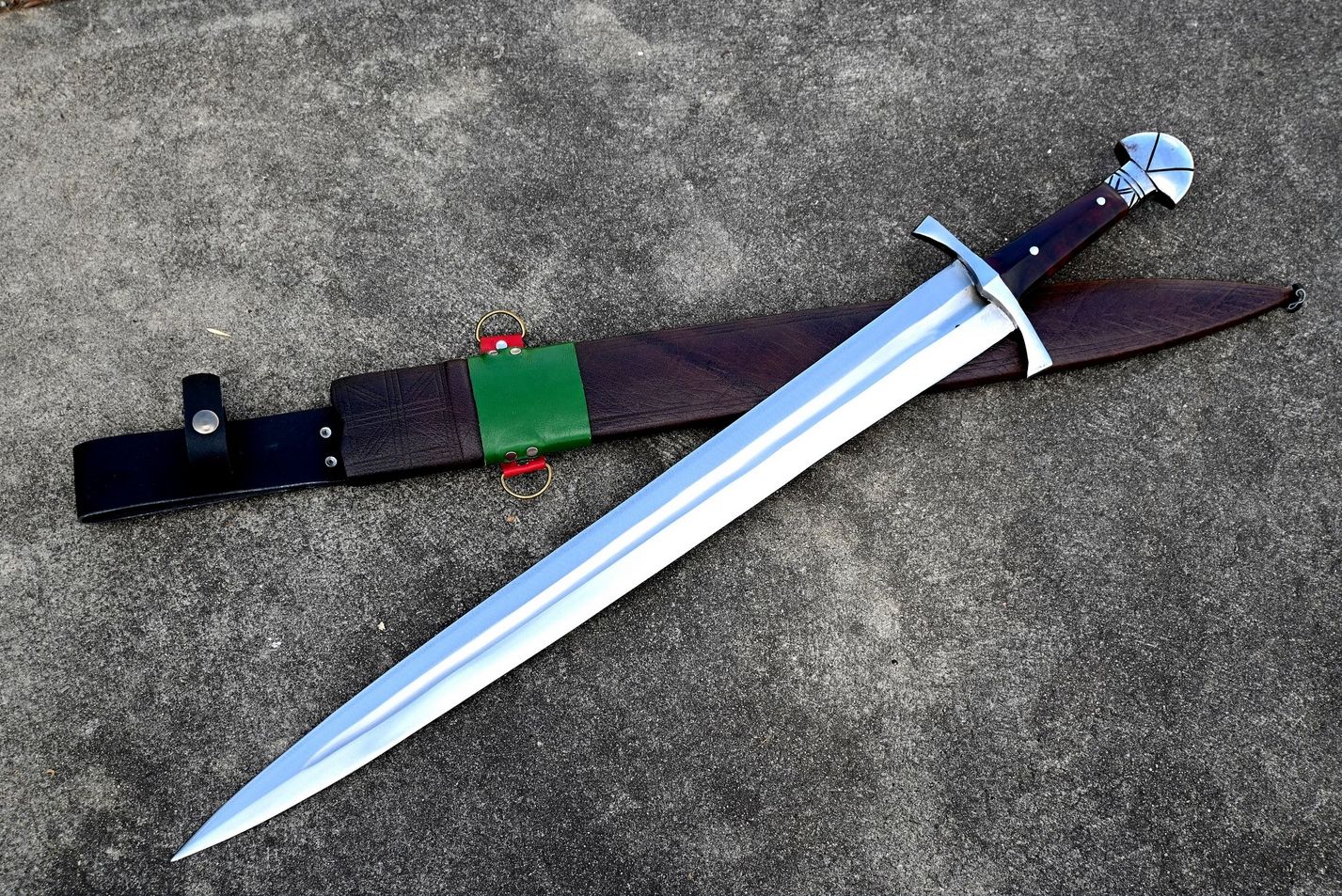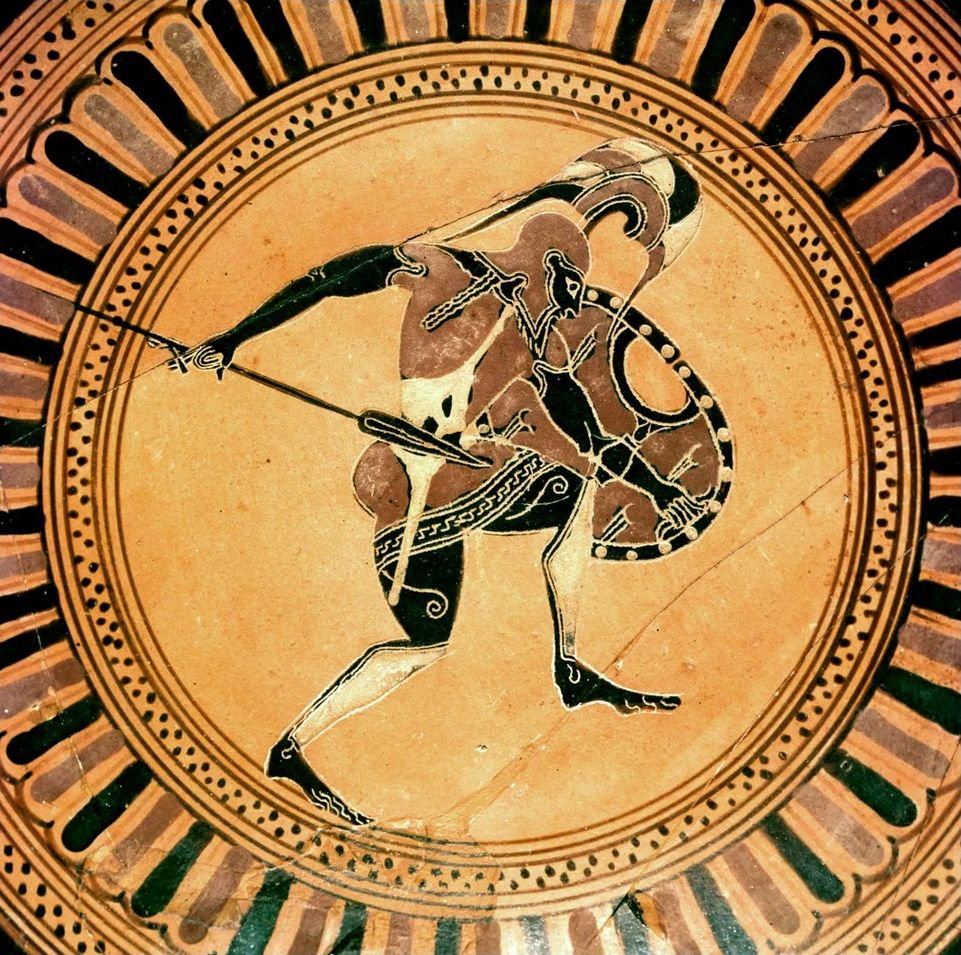Editor’s note: The following is extracted from Oxford Lectures and Other Discourses, by Sir Frederick Pollock (published 1890).
A Friday evening discourse at the Royal Institution of Great Britain, June 1, 1883.
There seems to be a culminating point not only in all human arts, but in the fashion of particular instruments. And it so happens that the preeminent and typical instruments of war and of music attained their perfection at nearly the same time, in the first quarter of the eighteenth century. Within that period the violin, chief minister of the most captivating of the arts of peace, and the sword, the chosen weapon of skilled single combat and the symbol of military honour, assumed their final and absolute forms—forms on which no improvement has been found possible. Strangely enough, the parallel holds a step further. In each case, although nothing more could be added to the model or the workmanship, it was yet to be long before the full capacities of the instrument were developed. A quartet of Beethoven hardly differs more from the formal suites and gavottes of such composers as Rameau than does the swordplay of the school of Prévost or Cordelois from the nicely balanced movements and counter-movements taught and figured in the works of Liancour or Girard. Nor has fencing been without its modern romantic school; we may even say that it has had its Berlioz in the brilliant and eccentric Bazancourt, a charming writer on the art, and as he has been described to me by competent authority—un tireur des plus fantaisistes. And in both cases we may truly say that the period of academic formality was the indispensable predecessor of the more free and adventurous development of our own time. But before the modern small-sword could even exist—the sword, as it is called eminently and without addition in its land of adoption, épée as opposed to sabre—a long course of growth, variation, and experiment had to be run through. To give some general notion of the forms and history of the sword is what I shall now attempt; I say some notion, for the subject, narrow as it may seem at first sight, is one that marvellously grows upon consideration. And though there are perhaps not many of us nowadays who would, like Claudio before he fell in love, walk ten mile a-foot to see a good armour,[1] I think we shall find the story not without interest.
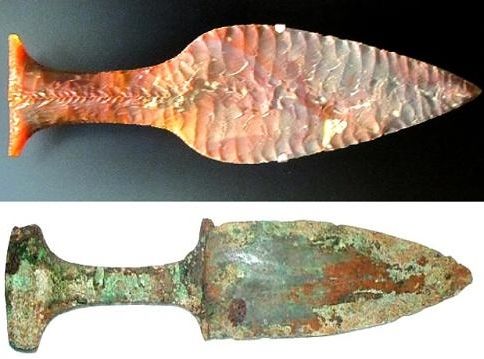
The sword is essentially a metal weapon. Here at the outset we are on disputable ground; one cannot take a part either way without differing from good authorities. But some part must be taken, and on this point I hold with General Pitt-Rivers. The larger wooden or stone weapons, clubs and the like, were not and could not be imitated in bronze in the early days of metal-work, for the one sufficient reason that metal was too scarce. We start then with spearheads of hammered bronze, imitating the pointed flints which doubtless were still used for arrow-heads until bronze was cheap enough to be thrown or shot away without thought of recovering it. The general form of these spear-heads was a kind of pointed oval, a type which has continued with only minor variations in the greater part of the spears, pikes, and lances of historical times. It is difficult to say whether the spears thus headed were oftener used as missile or thrusting weapons, though the javelin has also forms peculiar to itself, of which the most famous example is the Roman pilum. In the semi-historical warfare of the Homeric poems the spear is almost always thrown; in the later historical period it is held fast as a pike; the Romans, carefully practical in all matters of military equipment, had different spears for different kinds of service. In medieval Europe the missile use of spears had, I believe, disappeared altogether, except in the defence of walls and in naval combats. However these things may be, the need of a handier weapon than the spear for close quarters, and a readier and more certain one than the club, must have been felt at an early time. A spear broken off short would at once give a hand-weapon like the Zulu “stabbing assegai.” When metal becomes more abundant, and skill in working it more common, such weapons are separately designed and made; the spear-head is enlarged into a blade, with but little alteration of form, and we have a bronze[2] dagger of the type known to English archæologists as “leaf-shaped,” the characteristic type of the bronze period everywhere. Some of the Greek bronze daggers, indeed, are rather smaller than the full-sized spear-heads. With increasing command of metal the length of blade is increased; and we have in course of time a true sword. It is impossible to define where the dagger ends and the sword begins, but perhaps the metal-bladed weapon may fairly be called a sword when it is two feet long or upwards, and has a metal grip, or nucleus of a grip (the “tang” of the modern armourer), wrought in the same piece with it, and finished off with a counter-guard or pommel. It may be observed that the prehistoric armourers, as far as one can guess, had no theories as to the most effective length of their weapons. I believe the dimensions were determined (within the limits of practical handling by a man of average stature) almost wholly by the costliness of the material. In the later bronze and earlier iron periods we find the blades attaining almost or quite the length of a modern sabre. And in like manner the bulging curvature towards the point appears not to have been adopted in order to give cutting power (which to some extent it does), but to be a mere imitation of the spear-head, which in turn owes its form to imitation of the earlier chipped flint points. However produced, and for whatever reasons retained, this leaf-shape is the continuing type of the Greek sword throughout ancient Greek history; and it is not only thus persistent, but now and then recurs at much later times in unexpected ways. It is exactly reproduced in a pattern of short sword for the French dismounted artilleryman, dated 1816, which may be seen in the Musée d’Artillerie at the Invalides, and in some recent experimental sword-bayonets. As the blade lengthened, the leaf-shape was less marked, and in the days of the Roman empire, and the barbarian dynasties which were built up on its ruins, the symmetrical curvature had disappeared, leaving a straight and broad blade which became the European sword of the Middle Ages. Meanwhile the leaf-shape had thrown out other offshoots elsewhere. From the medieval type of sword, or in some cases from one of these other forms, are derived all the weapons of this class now employed by the European races of man.
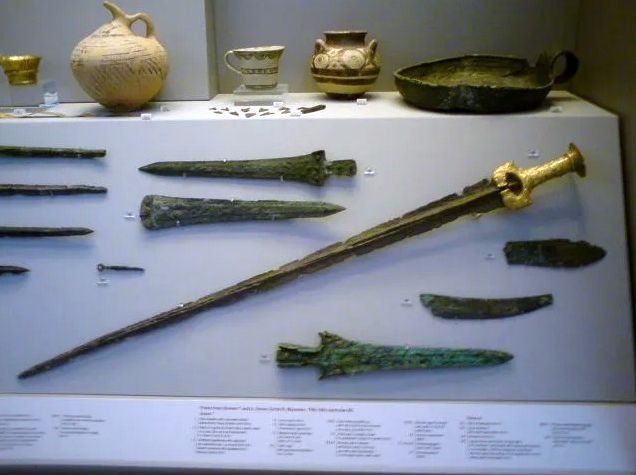
Even in the prehistoric period the leaf-shape underwent variations. There have lately been found at Mycenæ several sword (or rather dagger) blades of unknown antiquity, differing from the common pattern in being straight-edged; as likewise, it is worth while to note, are the swords figured on Assyrian sculptures, narrow and slender weapons mounted not unlike the Roman army sword, and apparently tapering to a point. There are Etruscan ones of the same type. The Mycenæan examples are elaborately decorated, and of the utmost interest as specimens of early artistic metal work. Two of them are considerably shorter than the others, and these are the most finely wrought. The blades are covered with hunting scenes and figures of animals, partly real and partly fabulous; the style of the work is archaic, and both the general style and certain details suggest an Egyptian origin for the school from which it came, if not for the artists themselves. The figures are not wrought in one piece with the blades, but made separately and let in. Some process of the nature of enamelling is used in parts, and gold, or alloys of gold and silver of different shades, are employed to give variety, and indicate to some extent the natural colouring of the objects. Whether imported or produced by a naturalised school of craftsmen, arms so richly adorned cannot have been at any time otherwise than a luxury confined to chiefs of the highest rank. These are of an antiquity far greater than that of the Homeric poems; and in Homer there is nothing that would lead us to expect such work, though decorated scabbards and mountings are mentioned. Swords occur now and then as presents, but there is no trace of their being peculiarly valuable possessions, and still less of any peculiar feeling of honour being associated with them. The spear is the favourite weapon of Homer’s mighty men, as witness the spear of Achilles which none but himself can cast. The sword is used only when the spear has failed, and seems to do little execution then. In historical Greece, and to some extent among the Romans, the military point of honour was bound up with the shield, probably because the abandonment of it was naturally the first action of defeated troops anxious to lighten themselves in retreat.
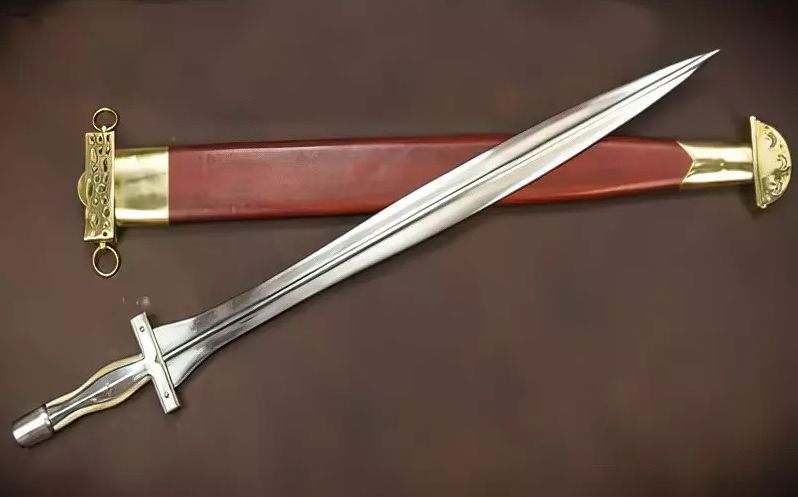
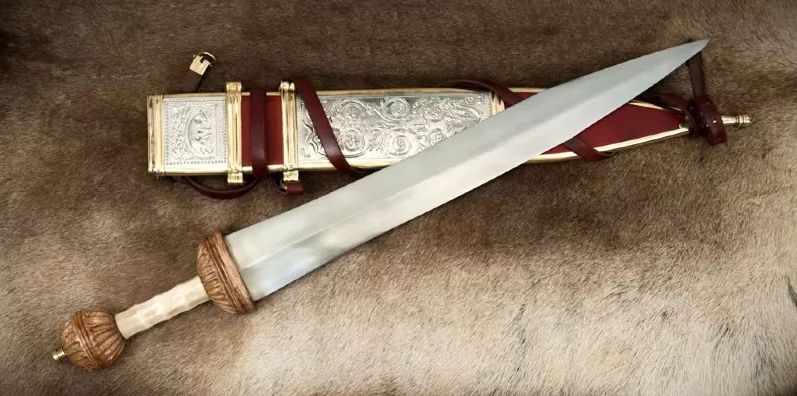
So far as anything can be inferred from the allusions of the Greek tragedians, and from a few historical details like the improvements in equipment introduced by Iphicrates, the sword had a better relative position among the arms of Greek warriors in post-Homeric times. Probably this was due to the supplanting of bronze by iron—a process which was complete so long before Thucydides wrote that iron was in his language the natural and obvious material of weapons. To wear arms is for him to wear iron: in old times, he says, every man in Greece “wore iron” in everyday life, like the barbarians nowadays. But it is in the Roman armies that we find the first distinct evidence of the use of the sword being studied with anything like system. We learn from Vegetius—a writer of the late fourth century A.D., and of no great authority for his own sake, but likely enough to have preserved genuine traditions of the service—that the Roman soldier was assiduously practised in sword exercise. What is more important, the Romans had discovered the advantage of using the point, and regarded enemies who could only strike with the edge as contemptible. Vegetius assigns as reasons for this both the greater effectiveness of a thrust and the less exposure of the body and arm in delivering it; reasons which though not conclusive are plausible, and show that the matter had been thought out. Further, the Roman practice, notwithstanding the temptation to keep the shielded side foremost, was to advance the right side in attacking, as modern swordsmen do. The weapon was a thoroughly practical one: the straight and short blade was mounted in a hilt not unlike that of a Scottish dirk, scored with well-marked grooves for the fingers, and balanced with a substantial pommel: this last point, by the way, is too much neglected in our present military swords. A shorter and broader pattern was worn by superior officers, sometimes in a highly ornamented scabbard, of which there is a very fine specimen in the British Museum. Longer swords were used by the cavalry and by the foreign troops in the Roman service. There is no evidence, however, that the Romans ever attained the point of cultivating swordsmanship in the proper sense, that is, making the sword a defensive as well as an offensive arm.
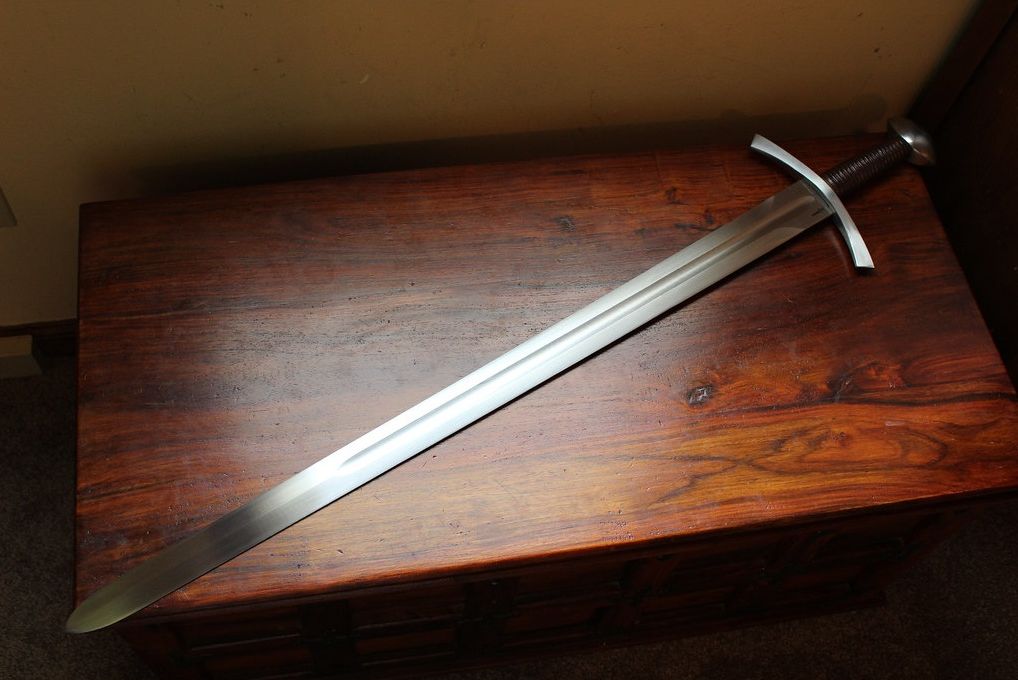
After the fall of the Roman empire the sword in general use is a longer and larger weapon, but handled, we may suspect, with less skill and effect. It is straight, heavy, double-edged, and of varying length apparently determined by no rule beyond the strength or the fancy of the owner. A good historical specimen of this type is the sword of Charles the Great, exhibited in the Louvre. As often as not the earlier mediæval swords are rounded off at the end; and from this, as well as from the fact that some centuries later the “foining fence” of the Italian school was regarded as a wholly new thing, it appears that the Roman tradition of preferring the point to the edge had been lost or disregarded. There is every reason, indeed, to believe that the mediæval form is the continuance of a prehistoric one. Swords dug up in various parts of Europe from several feet of gravel show no essential difference of pattern from those which were common down to the sixteenth century. The hilts of the prehistoric swords do indeed affect (though not invariably) a shortness in the grip which seems to modern Europeans absurd, though a parallel to it may be found in modern Asiatic swords; and very short handles occur in European weapons as late as the thirteenth century. From three to three and a half inches, or sometimes even less, is all the room given to the hand. The modern European swordsman’s grip is flexible; he requires free space and play for the fingers, and for the directing action of the thumb which is all but indispensable in using the point. The short grip is intended to give a tight fitting and rigid grasp, so that the whole motion of the cut comes from the arm and shoulder; and this is the manner in which Oriental swords are still handled. Apart from this difference in the size of the grip, a medieval knight’s sword, or one of the Scottish swords to which the name of claymore (commonly usurped by the much later basket-hilted pattern) properly belongs, has little to distinguish it from the arms of unknown date which, for want of a more certain attribution, are vaguely called British in our museums. But one thing of great curiosity happened to the sword in the Middle Ages; it became a symbol of honour, an object almost of worship, the chosen seat and image of the sentiment of chivalry. This may be accounted for in part by the accident of the cross-guard seeming to the newly converted barbarians to invest it with a sacred character; I say accident, for the cross-guard is certainly prehistoric and therefore pre-Christian. Still the religious associations of the cross must have given a quite new significance and importance to such customs as that of swearing by the sword—itself a widely spread one, and of extreme antiquity. I think that other though not dissimilar influences also came into play. In the Old Testament the sword is much oftener mentioned than the spear, and is a recognised symbol of war and warlike power. Thus, to take one of the best known passages, we read in the forty-fifth Psalm, “Gird thee with thy sword upon thy thigh, O thou most mighty:” in the Vulgate, Accingere gladio tuo super femur tuum, potentissime. Now it is no matter of conjecture that such a passage deeply affected the mediæval imagination. These words are quoted by a man of peace, our own Bracton, writing in the thirteenth century, when he speaks of the king’s power, and of the counsellors and barons who are his companions, girt with swords, assisting him to do judgment and justice. It seems hardly too fanciful to think that the fascination and pre-eminence of the sword which were at their height in Bracton’s time, and are not extinct yet, were in some measure derived from that one triumphant note of the Psalmist. Not that others were wanting; there is the two-edged sword in the hands of the saints: Exaltationes Dei in gutture eorum, et gladii ancipites in manibus eorum, a verse that was in time to serve the Puritans as it had served the Crusaders.
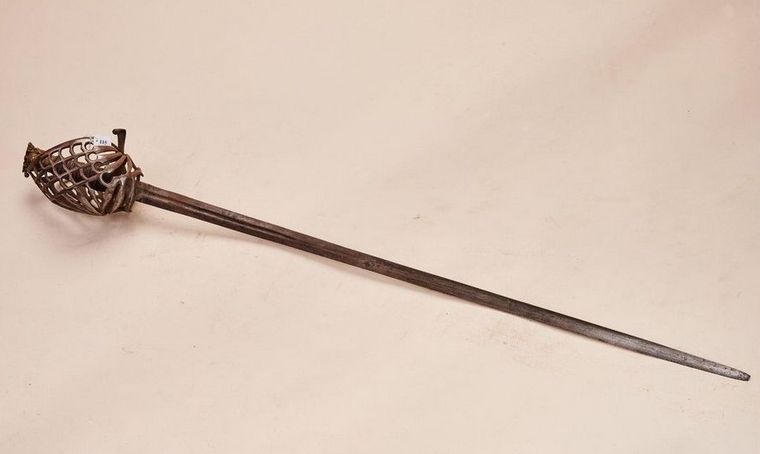
But to follow out the associations of the sword with knighthood, semi-religious military vows and enterprises, and military honour in general, would be matter for a discourse of itself. Let us return to the fashion and development of the weapon. There was little variation from the eleventh to the sixteenth century, save that the decoration of the scabbard and mountings (of which I do not propose to speak) grew more elaborate with the growth of art and luxury, and that the average length tended to increase. After the twelfth century the sword is generally pointed as well as two-edged, and the point was sometimes used with effect. In a fourteenth-century MS. in the British Museum, engraved in Hewitt’s Ancient Armour and Weapons, a mounted knight is delivering a thrust in quarte (as we now say), which completely pierces his adversary’s shield. In the sixteenth century the blade is made narrower and lighter, and the sword-hand is for the first time adequately guarded. First, the plain cross-bar puts on various curved forms intended to arrest or entangle an enemy’s blade with greater effect. Then rings project on either side of the root of the blade, and are worked, as time goes on, into a more or less complex system of convolutions according to the costliness of the weapon and the skill and fancy of the maker. These curved guards are known as pas d’âne, while the cross-pieces in the plane of the blade, now slender and elongated, and often curving towards the point, are called quillons. Next the guard throws up one or more branches, covering or encircling the exposed outer part of the hand. These branches form a shell or basket pattern, their ends are solidly joined to the pommel (after an interval of hesitating osculation, well exemplified in a sword now in the museum of the United Service Institution, which was borne by Cromwell at Drogheda), and nothing but a process of selection and simplification is now needed to produce all the modern patterns of sword-hilts. It was at Venice that the basket-hilt came first into regular use in the swords named Schiavone, from being worn by the Doge’s body-guard (Schiavoni, Slavs, i.e. Dalmatians). In these it is of a flattened elliptical shape. The Scots, renowned before the middle of the sixteenth century for their careful choice of weapons, took up the model, and in the course of another generation or two developed it into the well-known basket-guard still used by our Highland regiments, the most complete protection for the swordsman’s hand ever devised without undue loss of freedom. Meanwhile the pas d’âne solidifies into a hollowed disc or even a deep bell-shaped cup, the characteristic feature of the guard of the Spanish rapier and the modern duelling sword. One cannot help speaking of the works of men’s hands, when one traces them in historical order through their several forms, as if they were organic and grew like flowers, or like variations of a natural species; and in truth it is not an idle conceit, for the development of design and workmanship answers to a real organic development in the men from whose brain and hand the work proceeds; every generation takes up from its fathers, if it is worthy of them, a new starting-point of imagination and aptitude, and the strange conservatism of the imitative faculty is a sure warrant of continuity.
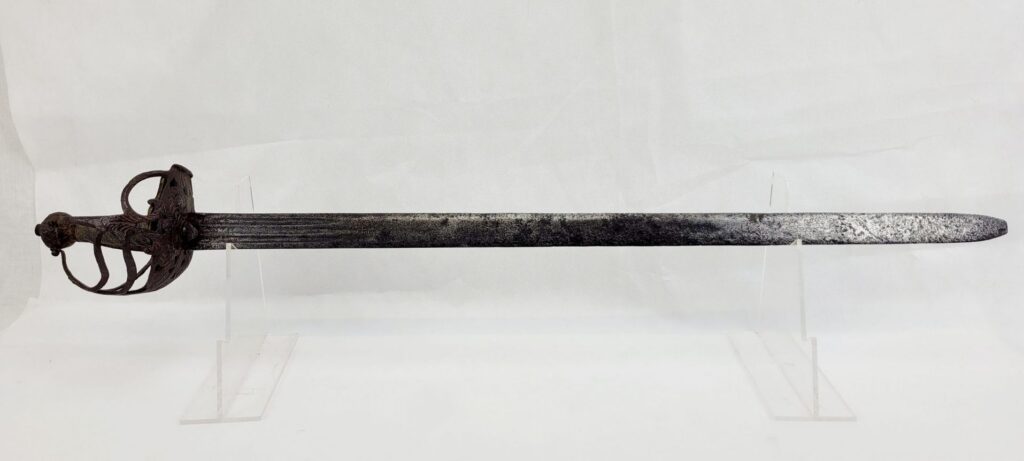
The latter half of the sixteenth century was the time when the sword stood highest in artistic honour. Then it was that Holbein designed its ornaments for Henry VIII, and that Albert Dürer engraved a crucifixion on a plate of gold for the boss of a sword or dagger of the Emperor Maximilian’s. Both the sword and its ornament disappeared at an early time, the prey of some greatly daring collector, and nothing is now known of their fate: the design survives, for impressions were taken as from an ordinary engraver’s plate, and some are still in existence, though a good example is extremely rare. But in the true armourer’s or swordsman’s eyes the work even of a Holbein and a Dürer is only extraneous adornment, and must yield in interest to the qualities of the blade. And at this time the sword-smith became again, as he had been in the ruder ages when metal working was the secret of a few craftsmen, a man of renown. In Spain, in France, in Germany, and in Italy, there rose up masters and schools of sword-cutlery. There was a time when the blades of Bordeaux and Poitiers had the best price in the English market; but soon those of Toledo, combining beauty, strength, and elasticity, gained that eminence of which the tradition still clings to them. Othello’s “sword of Spain, the ice-brook’s temper,” was such an one as these now before us. And Shakespeare, be it noted, knew here, as always, exactly what he was speaking of; for it was long believed that the quality of the finest blades depended on their being tempered in mountain streams. Germany was not far behind in the race either; the Solingen blades, stouter and rougher than the Spanish ones, but for that reason fitter for common military service, made their trademark of a running wolf known throughout the north of Europe. The wolf, or hieroglyphic symbol that passed for one, was easily taken for a fox. Hence, it should seem, the cant name of fox for a sword, which is current in our Elizabethan literature. “O, Signieur Dew, thou diest on point of fox,” cries Pistol to his captive on the field of Agincourt. A still greater reputation was gained by the strong and keen broadswords bearing the name of Andrea Ferara, long a puzzle to antiquaries from the want of positive knowledge whether he was of Italian or Spanish origin. The story that he was invited to Scotland by James V appears to be mere guess-work. There exists, however, contemporary evidence that some time after 1580 two brothers, Giovan Donato and Andrea dei Ferari, were well known sword-makers, working at Belluno in Friuli, the Illyrian territory of Venice; and this goes far to settle the question between Spain and Italy. Probably the name of Ferara became a kind of trade-mark, and was used afterwards by many successors or imitators.
During this time the Spanish and Italian rapier was undergoing its peculiar development, and leading the way to the modern art of fencing. But this takes us out of the general line of history into a distinct branch. We have henceforth to consider the sword, not as the simple following out of a given primitive form, but as a weapon diverging from that form in two directions. It may be specialised as a cutting or as a thrusting arm. In the military sabre of our own time we find both qualities reconciled by a sufficiently effective compromise, but only after a long course of experiments.
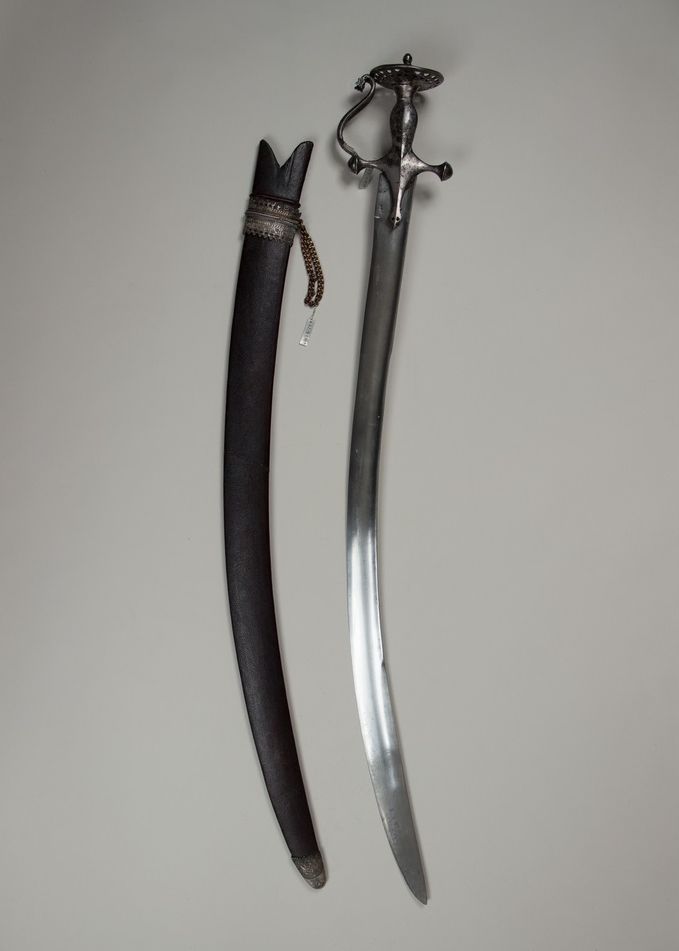
For many centuries the armourers and swordsmen of the East have cultivated the edge at the expense of the point, and have attained a partly just and partly fabulous renown. The point, after being neglected since the days of the Romans, has made up its lost time in the West, and made it up triumphantly; for it is now admitted that the swordsman who would be a complete master of the edge must have learnt the ways of the point also. Let us take the earlier stage first, as shown in the cutting swords of the East. Broadly speaking, their characteristic feature is a decidedly curved blade as opposed to the straight or nearly straight European form. Not that all old European swords are straight, or all Eastern swords curved. There are curved blades of medieval and even earlier times (one prehistoric example is in the Copenhagen Museum), and one remarkable type of Indian sword, the Mahratta gauntlet sword (Patá), is quite straight; but the contrast holds good in the main. The object of curvature is to gain cutting power. When a straight sword strikes its object full, the direction of the stroke is at right angles to the length of the blade; and the amount of resistance, for a given velocity of stroke and substance to be cut, is measured by the acuteness of the angle shown by a transverse section of the cutting blade. The finer this angle, the less the resistance. In the case of an instrument not intended to bear rough usage or cut hard bodies, or much of any substance at one stroke (as a razor), it is only a question of workmanship how fine the angle can be made. But with a sword it is otherwise. Without a certain amount of thickness, the best steel blade would be too fragile or too flexible, so that in practice the limit up to which its cutting power can be increased by fining down the edge is soon reached. But now let the blow be delivered in a direction not at right angles, but oblique to the axis of the blade. The angle of resistance will then be given by an oblique section of the blade, and in proportion to the obliquity it will be finer than the angle of a straight cross section. It is on exactly the same principle that the steepness of a road or path on a mountain side is diminished by giving it a zigzag course. With a straight edge this effect can be produced by what is called a drawing cut. But it is far more simply and certainly produced by giving a permanent curvature to the edge in the part where the stroke falls. A weapon thus formed cannot help presenting an oblique section of the blade in the act of cutting, and therefore will cut better than a straight weapon of similar transverse section. This is the principle of all curved swords, exemplified in the choice Persian blades, in the common Indian sabre (Talwár), and in the light cavalry sword of almost identical pattern which was used in our own service in the Peninsular and Waterloo campaigns. Near the hilt the blade is nearly straight, but towards the centre of percussion it bends rapidly away. This effect is enhanced by mounting the sword so that the initial direction of the blade, from which the curve falls back, makes a sensible angle with the line of direction of the hilt, and goes before it to meet the object struck at ; in the sword-smith’s terms, by making the edge “lead forward.” Hence the elegant double curve made by the blade and hilt of the Persian sabre. The same rule is followed, though less obviously, by the most recent European patterns. In Japanese swords it is reversed, for some reason which I have never seen explained.
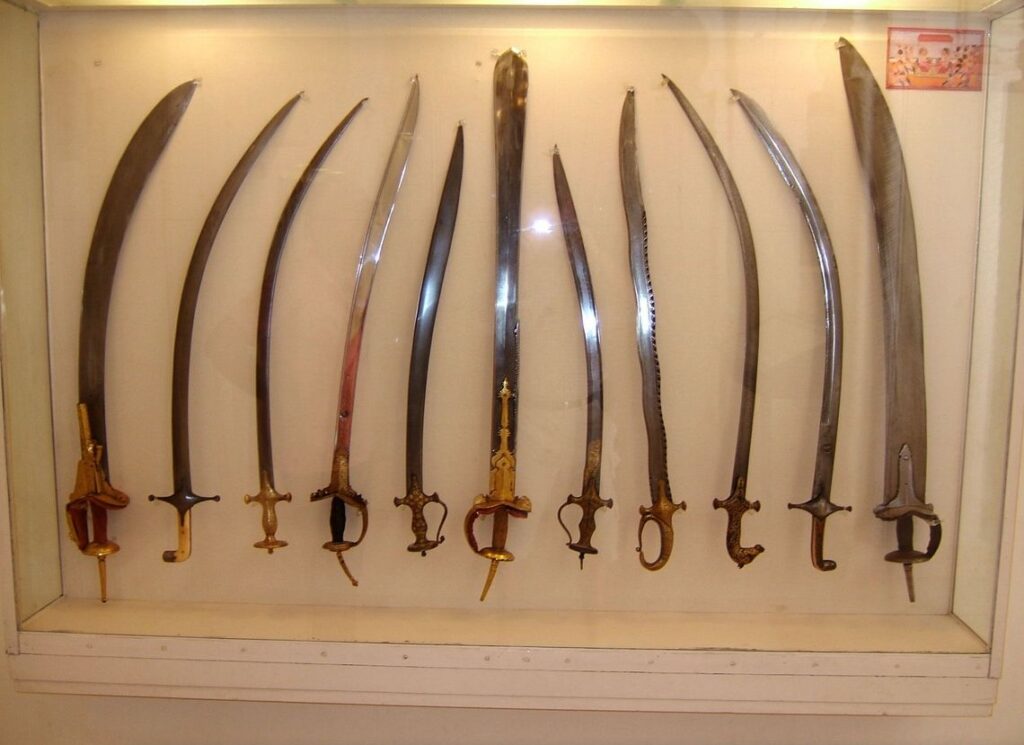
The use of a curved blade is of unknown antiquity in the East. Its most ancient form was probably short, and broader at the point than at the handle (the scimitar properly so called); an exaggerated representation of this type is the conventional weapon of Orientals and barbarians among the painters of the Renaissance or even later. Passing over earlier stages, however, let us come to the sabre which was made known to Western Europe by the crusades, and whose form and fashion have continued to our own day without notable change. These Indian and Persian arms exhibit the perfection of a specialised type. Great cutting power is gained by the curvature, which ensures an oblique section of the blade, and therefore an acuter angle of resistance, being presented to the object struck. Everything else is sacrificed to the power of the edge, and sacrificed deliberately. The small grip and the partial or total neglect of protection for the sword-hand are part of the same plan. Defence is left to the shield and armour. The curious projecting pommel of the commonest pattern of Indian sabre may act, indeed, as a guard for the wrist, but it has other uses; it may become a weapon of offence at close quarters, it balances the weight of the blade, and it may be grasped with the left hand for a two-handed blow. Scottish broadswords not uncommonly have a kind of outside loop made in the hilt for the same purpose.
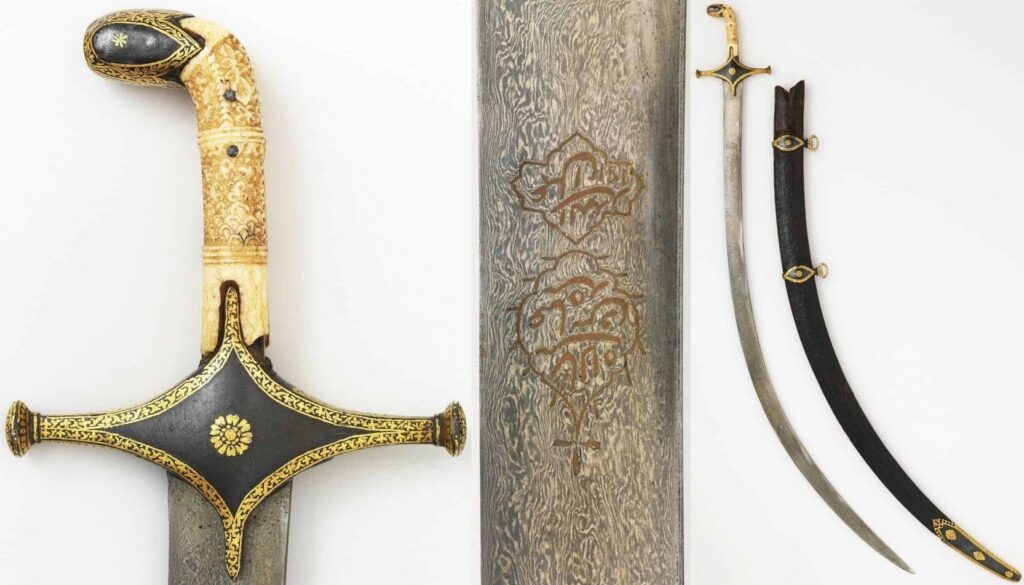
More time and labour have been given to the making and adornment of choice weapons in Syria, Persia, and India than in any other part of the world. The best steel always came, it appears, from India. Damascus has given its name to the characteristic processes of Oriental metal-work, but has long been supplanted by Khorassan as the chief seat of the art: nevertheless, Damascus blades, or what purport to be such are still freely sold to travellers in the East. One such purchaser, I am told, observed that a number of these swords had the same inscription in Arabic characters. He was unable to read it himself but afterwards consulted an Orientalist, who informed him that the writing signified— “I am not a Damascus blade.” It may be believed that the interpretation was faithful, for the jest is quite in the Persian manner. The damasked or “watered” appearance of the blades which are most highly esteemed in the East appears to have been originally due to an accidental crystallisation of the steel in the process of conversion. The production of it was long thought a secret, but Western experts have now both explained and imitated it.
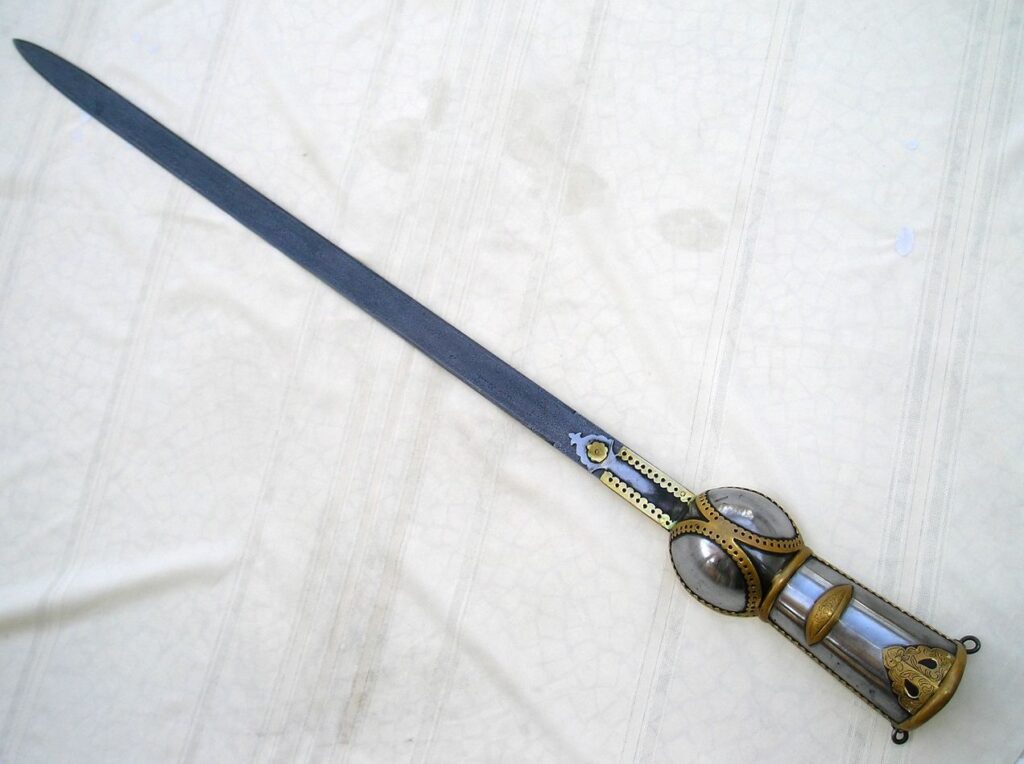
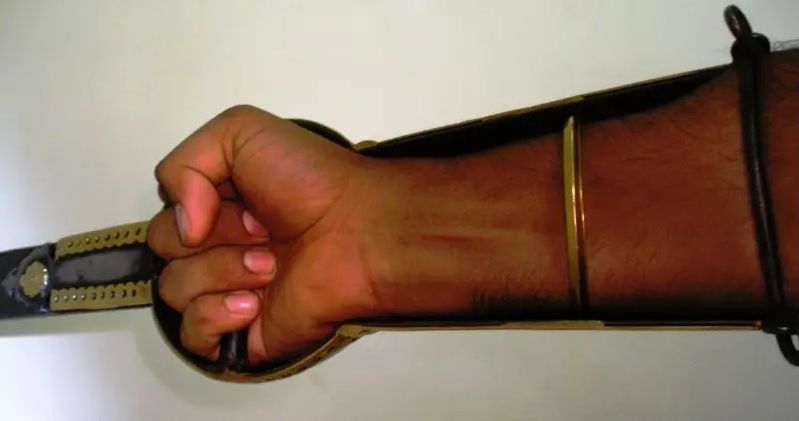
While we are among Indian weapons, we may learn from them that the development of the sword from the dagger by successive steps and modifications is not a matter of mere archæological conjecture. Almost conclusive proof is given by the series of intermediate forms between the straight broad dagger (Katár), with a handle formed by a pair of cross-bars set close together between two other bars parallel to the axis of the blade which serve as hand-guards, and the long sword with gauntlet hilt called Patá. The dagger, as far as the blade goes, is of a widespread type: the medieval short swords, for example, called by modern antiquaries “anelace” or “langue-de-bœuf ” (though there is some doubt as to what anelace or anlas, a name peculiar to England and of unknown origin, really means), are not unlike it. But the mounting is peculiar, and enables us to follow the transitions. First the blade is made about a third or a half longer. Then a kind of shell covering the back of the hand is added to the bars of the hand-guard. In this form the weapon is called “Bara jamdádú” (death-giver), and seems to be known only in a limited part of Southern India. Finally the blade is lengthened into a double-edged sword, and the hand-guard is closed in so as to make a complete gauntlet-shaped hilt. The original cross-bar handle remains, making the grip entirely different from that of an ordinary sword. One does not see how an arm thus mounted can be used except for a sweeping blow, no room being given for the slightest play of the wrist. It is not uncommon to find old Spanish or other European blades mounted in these gauntlet hilts—a fact worth noticing, to correct the popular impression that Eastern swords are better than European ones. This is far from being generally true. Not only may old Spanish, Italian, or German blades be found in collections of Oriental arms, but in quite modern times Indian horsemen have been known to use by preference English light cavalry swords, remounted in their own fashion, and to do terrible execution with them. European swords have been found ineffective in Indian warfare, not because they were bad in themselves, but because they were not kept sharp like the Indian ones. “A sharp sword will cut in any one’s hand,” said an old native trooper to Captain Nolan in answer to questions as to the secret of the Indian horsemen’s blows. And if European sword-smiths do not produce habitually such elaborate work as those of Persia and Damascus, it is not because they have not the secret of their Eastern fellow-craftsmen, but because the time and expense required for watered blades are such as would not be compensated by the price obtainable in the Western market. Only in the East, where men seem to take no count of time, and where centuries have passed without historians and without any means of fixing dates, could this branch of the armourer’s art have arisen, or be regularly practised.
Similarly, we have all read in Walter Scott’s Talisman the spirited (though, it must be confessed, inaccurate)[3] description of the sword-feats performed by Richard and Saladin; and most readers probably imagine the cutting of the cushion and the veil to require some temper to be found only in Oriental blades, or some refinement of address peculiar to Oriental hands. But these and other feats of Eastern swordsmen have been and are repeated with success by Europeans in our own time. It is true that a light and very sharp sword, not the service arm, is used for that special purpose.
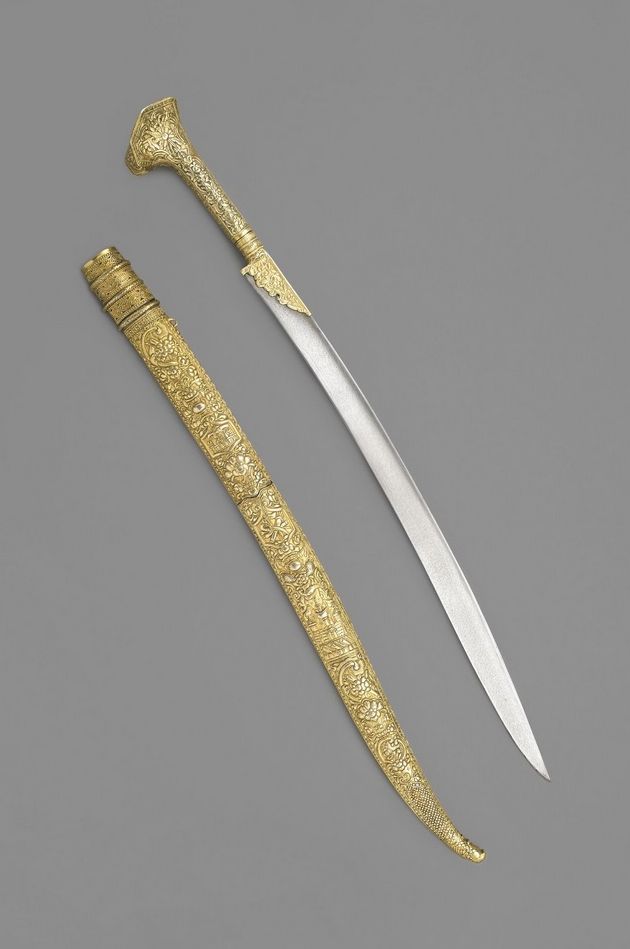
Various peculiar types of curved swords and more or less similar weapons occur in different parts of the East. One which deserves special mention, from the distances to which it has travelled, is the yataghan type. The doubly-curved blade of the yataghan, still a constant part of the armed Albanian’s equipment, and a favourite Turkish weapon, is identical in form with the short sword or falchion (Kopis) figured on sundry Greek monuments, and with the Kukri of Nepal. This last, indeed, is commonly broader and more curved; but there is an elongated variety of it which cannot be distinguished from the yataghan, and which occurs in Nepal itself, in the Deccan, and in Sind. A precisely similar arm, probably imported by Roman auxiliaries, has been found at Cordova and elsewhere in Spain, and may be seen in the Pitt-Rivers collection and the Musée d’Artillerie. It makes a very handy and formidable weapon, combining, if not too much curved, a strong cutting edge with considerable thrusting power. Of its birthplace, I believe, nothing is known; it is more or less used in all the Mahometan parts of Asia, and the geographical distribution would point to Persia or thereabouts for a common origin; but then Persia is just the country where the thing seems to be least common, and the word is purely Turkish. It is not impossible that, notwithstanding the strong temptation to make out a pedigree, we have here a case of independent invention in two or more distinct quarters; and in fact the Kukri of the Gurkhas is stated (on what authority I do not know) to be derived from a bill-hook used for woodcutter’s work in the jungles. In modern times the yataghan has been the parent of the French sword-bayonet, and it was even proposed by Colonel Marey, the author of a full and ingenious monograph on the forms and qualities of swords, to make the infantry officer’s sword of this pattern.
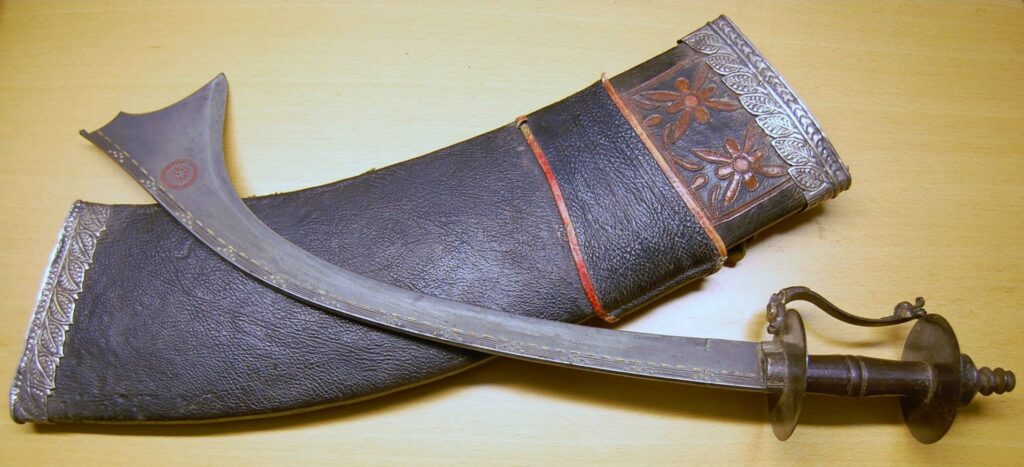

There are many kinds of outlandish weapons, in Nepal and farther east, of which the edge has a concave instead of a convex curvature. I doubt whether these be properly swords; at all events, they have had no influence on European forms. The Japanese swords also stand by themselves, though they are historically nothing but a superior variety of the general type which is found in China and Burmah, and to some extent in the Malay archipelago. They are exceedingly sharp, but have no flexibility at all. It may be worth noting that the custom of wearing two swords, which has been the occasion of some curiosity and conjectural explanation, is not confined to Japan. Certain Arabs in the Mahratta service are stated to have done the same. The two swords of the Japanese, however, are of such different sizes as to be rather comparable to the sword and dagger of Europeans, and perhaps there is really nothing to explain.

We pass now to the other special line of development, that of the rapier and small-sword. Whatever differences of opinion may be possible about the sabre, there can be no doubt that the straight sword which ultimately became a thrusting sword is an extension of the dagger. The East is rich in daggers of many forms, so rich that in India alone a score of distinct names for distinct varieties of the weapon appear to be current. There is a broad difference, however, between the straight and the curved daggers, and the modes of using them; the straight ones being held like a sword, the curved ones the reverse way, with the little finger next the blade. Among the curved species is one of which the shape would be puzzling if it were not known to be simply copied from a buffalo horn. The proof is that a dagger of this class is sometimes nothing but the split and sharpened buffalo horn itself. I am not sure that all the curved daggers may not be due to some imitation of this kind, and thus be quite unconnected with the course of development leading up to the modern sword. That the curved sabre is modified from a straight sword, not enlarged from a curved dagger, is, I think, too plain for discussion. The broad-bladed straight dagger which lengthened into the gauntlet-hilted sword has already been mentioned. But neither in this nor in any other case does the enlargement of the dagger appear to have suggested in the East the fabrication or use of a full-sized sword with thrusting for its chief or sole purpose. The rapier, the duelling sword, and the art of fencing, are purely Western inventions. Before going further, let us put a needful distinction of terms beyond mistake. A duelling sword and a rapier are not the same thing, though they are often confused. The rapier is a cut-and-thrust sword so far modified as to be used chiefly for pointing, but not to the complete exclusion of the edge. The duelling sword is a weapon made, and capable of being used, for pointing only. Such a construction would be naturally first applied to the dagger, as its cutting edges could never be of much offensive service unless it were of a large and clumsy type. Cutting power being once regarded as secondary or superfluous, the two-edged blade is narrowed for convenience of carriage, perhaps also of concealment, until thickening becomes necessary to make it strong enough. This reinforcement may be effected by a ridge on either side of the blade, or by a ridge on one side only, which soon becomes as much or as little of an edge as the original and now degraded edges of the blade. From the narrow two-edged blade strengthened by a single “median ridge” we get a purely thrusting blade of triangular section, or an approximately bayonet-shaped blade as we should now call it. From the blade with a double “median ridge” we get a blade of quadrangular section, not corresponding to anything now in familiar use. Both the three-edged and the four-edged shape occur among mediæval daggers; they are also found, though exceptionally, in Indian specimens. It is difficult to say when they were introduced. We have a distinct record of three-edged swords or long daggers having been employed at the battle of Bovines (A.D. 1214); they are specially described by the chronicler as a novelty. But no example of so early a date appears to be either preserved or figured anywhere; and it was as nearly as possible five centuries afterwards that the bayonet-shaped small-sword prevailed over the rapier. It is worth noticing that some of the Scottish broadswords of the late seventeenth and early eighteenth centuries have a “median ridge” so strongly marked as to make them almost three-edged.
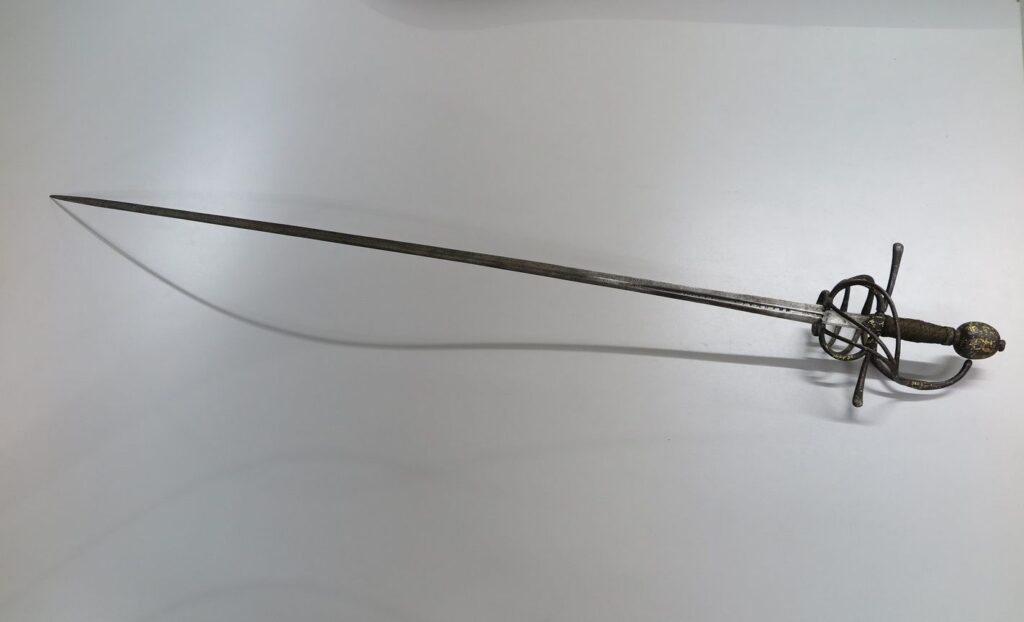
As for the two-edged rapier, its parentage is obvious. It is the military sword of all work, in the form it had assumed in the first half of the sixteenth century, lengthened, narrowed, and more finely pointed. The interesting question is, what led to the use of the point being studied and developed at that particular time. It may seem a paradox to say that the art of fencing is due to the invention of gunpowder; but I believe it to be true. So long as the body was protected by armour, there was no necessity and no scope for fine swordsmanship. Hard hitting was the only kind of attack worth cultivating. Fire-arms, however, made armour not only of less value, but at short ranges a source of positive danger, just as nowadays, when the side of an ironclad is once penetrated by shot, the splinters make matters worse than if there had been no resistance at all. Armour being abandoned as worse than useless against fire-arms, it became needful to resort to skill instead of mechanical protection for defence against cold steel at close quarters. Various experiments were tried; the shield was reduced in dimensions to make it more manageable, and in England sword and buckler play, which had long been a favourite national pastime, still had, at the very end of the sixteenth century, its zealous advocates against the newfangled rapier. But the point, of no avail against complete armour, soon manifested its superior power when this barrier was removed. There is some obscurity about the local origin of the rapier and of fencing. The finest old rapiers are Spanish, and there is mention of very early Spanish books on the subject, which, however, do not seem to be extant. And it has been said that the rapier was imported into Italy by the Spanish armies early in the sixteenth century. So far as I have been able to learn, however, there is no real evidence of this.
From Italy the fashion came into France and England, and spread apace, not without grumbling from the older sort of gentlemen and soldiers, of which the echoes are yet audible to us in sundry passages of Shakespeare. At some time between 1570 and 1580 the rapier became the favourite companion of the exquisites of London. “Shortly after (the twelfth or thirteenth year of Queen Elizabeth),” says Howes, the continuer of Stow’s Annals, “began long tucks, and long rapiers, and he was held the greatest gallant, that had the deepest ruff and longest rapier; the offence to the eye of the one, and the hurt unto the life of the subject that came by the other, caused her Majesty to make proclamation against them both, and to place selected grave citizens at every gate to cut the ruffs and break the rapiers’ points of all passengers that exceeded a yard in length of their rapiers, and a nail of a yard in depth of their ruffs.” A later writer fixes the date of this proclamation to 1586, and adds that it forbad rapiers to be “carried, as they had been before, upwards in a hectoring manner,” but says nothing of the ruffs. In 1594-95 two English treatises appeared on the new art of fence, one translated from the Italian of Giacomo di Grassi, the other the work of Vincentio Saviolo, an Italian master established in England. The translator of Grassi tells us in his “Advertisement to the Reader,” that “the sword and buckler fight was long while allowed in England (and yet practice in all sorts of weapons is praiseworthy), but now being laid down, the sword, but with serving-men, is not much regarded, and the rapier fight generally allowed, as a weapon because most perilous, therefore most feared, and thereupon private quarrels and common frays most shunned.” On the other hand, some partisans of the old sword and buckler play maintained its excellence on the express ground that men skilled in it might fight as long as they pleased without hurting one another; and others denounced the rapier as “that mischievous and imperfect weapon which serves to kill our friends in peace, but cannot much hurt our foes in war” (George Silver, Paradoxes of Defence, 1599). But they were soon discomfited. In 1617 we find one Joseph Swetnam, a garrulous and not original author, declaring that the short sword or back-sword (a stout sword so called from having only one edge) is against the rapier “little better than a tobacco pipe or a fox tail.” We must not suppose that the rapier fight of the sixteenth century resembled modern fencing. It was the commoner practice to hold a dagger in the left hand for parrying; this, by the way, has an odd analogy in China, where instruments like blunt skewers are used for the same purpose. And not only did the use of the dagger, or in its absence of the gauntleted left hand, make the conditions different from those of the modern fencing-school, but the principles and methods were as yet crude and unformed. The fencing-match in Hamlet is commonly presented according to the modern fashion, though M. Mounet-Sully’s treatment of it constitutes a distinguished exception, and Dumas and Gautier, both of whom knew the historic truth well enough, freely introduce the modern terms and rules into the single combats of their novels. In each case this course may be justified by artistic necessity. But if we look to the engravings in Saviolo or Grassi, we shall find that Hamlet and Laertes, when the play was a novelty at the Globe Theatre, stood at what would now be thought an absurdly short distance (for the lunge, or delivery of the thrust by a swift forward movement of the right foot and body, with the left foot as a fixed point, was not yet invented) with their sword-hands down at their knees, the points of their rapiers directed not to the breast but to the face of the adversary, and their left hands held up in front of the shoulder in a singularly awkward attitude. A great object was to seize the adversary’s sword-hilt with the left hand and this probably explains the “scuffling” in which Hamlet and Laertes change foils—a thing barely possible in a fencing-match of the present day. An incidental illustration of the part of the left hand in defence is given in Romeo and Juliet, where it is related that Mercutio
with one hand beats
Cold death aside, and with the other sends
It back to Tybalt.
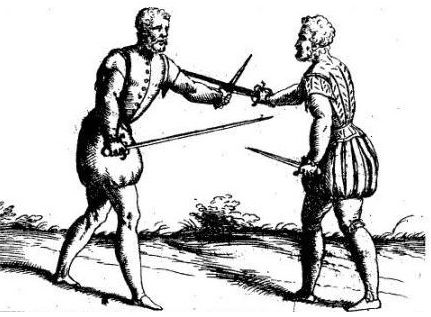
The duel with rapier and dagger had particular rules of its own; and the handling of a “case of rapiers” (that is, a rapier in either hand) was also taught, but, one would think, only for display.
During this period the use of the edge was combined with that of the point, but the point was preferred. “To tell the truth,” says Saviolo, “I would not advise any friend of mine, if he were to fight for his credit and life, to strike neither mandrittas nor riversas” (the technical names of direct and back-handed cuts), “because he puts himself in danger of his life; for to use the point is more ready, and spends not the like time.” In the books of the seventeenth century the instructions for mandrittas and riversas disappear accordingly, and at the beginning of the eighteenth we find the small-sword in existence and the rapier gradually giving place to it. Experiments had already been made with thrusting blades of triangular or quadrangular section; at least, specimens of such, ascribed to the early seventeenth or even the end of the sixteenth century, may be seen in museums. In some of these cases, however, one would like to ascertain that a more recent blade has not been mounted in a hilt of the period attributed to the weapon. Be that as it may, the small-sword completely prevailed over the two-edged rapier some time about 1715. At the same time that the form of the blade was changed, its length, which had been excessive, was reduced to a handier and not less effective compass. A sword 36 inches long was reckoned short at the beginning of the seventeenth century, and some rapiers extend to four feet and more. The standard length of the modern small-sword and its representative for fencing purposes, the foil, is from 32 to 34 inches only. Sir William Hope, of Edinburgh, writing in 1692, considers three-quarters of an ell to be “an indifferent good length,” that is, “neither too long, which would be unhandsome (i.e. unhandy or clumsy), nor too short, which would be very inconvenient”: taking the ell at 45 inches, this comes very near the present measure. regards the mounting and guard also, there was a marked return to simplicity. The elaborate work of the Spanish rapier-hilts disappears, to be replaced by a plain shell guard for the duelling sword, and a very light hilt, capable, however, of much decoration if desired, for the walking-sword which every gentleman habitually wore until near the end of the last century. Meanwhile the art of fencing made rapid progress, and may be said to have been fixed in substance upon its modern lines by 1750 or thereabouts. To give an account of its development before and since that time would require not a part of a discourse, nor a whole discourse, but a book. Such a book, strange to say, does not yet exist, not even in France, the chief seat of the art ever since the first half of the seventeenth century, when the supremacy passed to her from Italy. The lunge had, indeed, been taught and figured by Italian masters; but the riposte, which is the very life of modern fencing as a system of combined defence and offence, is undoubtedly a French invention. All the modern authorities of much value are either French or openly founded on the French school. It must not be forgotten, however, that there exists a distinct Italian school, which has never adopted the three-edged sword. Its weapon is a two-edged rapier with cup guard and cross-bar, and its play, though less various than the French, is perhaps not less formidable.
One is tempted in the various forms and uses of the sword to see a reflection of the general temper, and even the tastes and style of the age. The sword of each period seems fitted by no mere accident to the gentlemen, both scholars and soldiers, like Bassanio, who wore and handled it. The long rapier, with its quillons and cunningly wrought metal-work, and the rigid hand-hold which the modern Italian swordsmen still use, is a kind of visible image of the stately and involved periods of Elizabethan prose. I can persuade myself that it was not in the nature of things for Sidney or Raleigh to be otherwise armed. When we come to the great forerunners of modern English, Hobbes (who has in nowise forgotten to put a sword in the right hand of the mystical figure representing the might of the State in the frontispiece to his Leviathan) seems to wield an Andrea Ferara, such a blade and so mounted as Cromwell’s, dealing nimbly and shrewdly with both edge and point. And in the exquisite dialectic of Berkeley and Hume, as clear and graceful as it is subtle, and without a superfluous word, we surely have the true counterpart of the finished play of the small-sword, the perfection of single combat. Warfare is on a grander scale now, the controversies of philosophers as well as the campaigns of generals. There are modern philosophical arguments which profess to be more weighty, as they are certainly more voluminous, than Hume’s or Berkeley’s, and which remind one not of an assault between two strong and supple fencers in which every movement can be followed, but of a modern field-day, where there is much hurrying to and fro, much din, dust, and smoke, and extreme difficulty in discovering what is really going on.
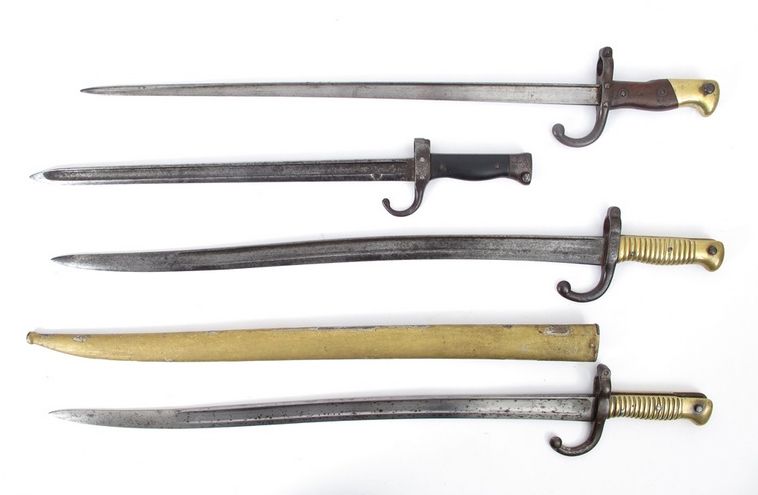
But our story is not fully done. At the same time, or almost the same time, with the small-sword there came in an offshoot of this class of weapons which has a curious little history of its own, namely the bayonet, a modified dagger in its immediate origin, but influenced in its settled ordinary form by the small-sword, and by the sabre and yataghan in various experimental forms which have ended in the sword-bayonet largely used in Continental services, and to some extent in our own. There is a recent French pattern of this weapon in which the yataghan curve is abandoned; though quite straight, it still has only one edge. It seems a considerable improvement on the shape which we copied many years ago from an older French model, and have now discarded to return to a simple dagger form. There have been some rather pretentious writings in France and elsewhere about the reduction of bayonet practice to a system; I am inclined to think that a man who knows how to use the point of a sword (the necessary foundation of all skill in hand-weapons) will very soon learn what the bayonet is and is not capable of.
A word is also due to the modern military sabre. This, broadly speaking, is a continuation of the straight European military sword of the sixteenth century, lengthened and lightened after the example of the rapier, but one-edged instead of two-edged (which, according to the French authorities, is the decisive mark of sabre as distinguished from épée), and in many cases more or less curved after the fashion of the Eastern swords. Meanwhile, the long straight sword has thrown out a most eccentric development, or even “sport,” in the shape of the German Schläger with which students’ duels are fought. This is too remotely connected with the main part of the subject to be dwelt upon here; the duels in question, for the rest, have been often and pretty recently described by English observers. The rapier and the small-sword are weapons of single combat, not of general military use; the small sword is too fragile, the rapier both too fragile and too long, for a soldier’s convenience. It is true that it was proposed by no less an authority than Marshal Saxe to arm cavalry with long bayonet-shaped swords, and his opinion has been followed by at least one modern writer. But it is founded on the erroneous notion that a good cutting sabre cannot have a good point, and therefore either the edge or the point must be wholly sacrificed; a notion which has so far prevailed that late in the eighteenth century an excessively curved light cavalry sabre (apparently copied with close fidelity from an Indian model) was introduced throughout the armies of Europe. It was the weapon of our light dragoons all through the Peninsular and Waterloo campaigns, and effective for cutting, but almost or quite useless for pointing. Even now there remains a certain difference in most services between the shape of the light and the heavy cavalry swords, the heavy cavalry sword being straighter, or sometimes perfectly straight. But it is pretty well understood by this time that one and the same sword can be made, though not so perfect for thrusting as the duelling sword, nor so powerful for cutting as an Indian talwár or the old dragoon sabre, yet a very sufficient weapon for both purposes. A blade of moderate length, not too broad, and lightened by one or more grooves running nearly from hilt to point, may be shaped with a curve too slight to interfere gravely with the use of the point, yet sensible enough to make a difference in favour of the edge. This plan is now generally followed. It may still be doubted whether for effective fighting purposes we have improved much or at all on the cavalry swords of the sixteenth and early seventeenth centuries.
The use of the edge, after being unduly neglected in consequence of the startling effectiveness of the rapier-point, has also been more carefully studied in modern times. Closely connected with the error just now mentioned, that the same blade cannot be good for both cutting or thrusting, is an equally erroneous belief that a cut cannot be delivered with sufficient force except by exposing one’s whole body. The old masters of rapier-fence already knew better. What says Grassi in the contemporary English version? “By my counsel he that would deliver an edge-blow shall fetch no compass with his shoulder, because whilst he beareth his sword far off, he giveth time to the wary enemy to enter first; but he shall only use the compass of the elbow and the wrist: which, as they be most swift, so are they strong enough if they be orderly handled.” This is exactly what the best modern teachers say. Though sabre-play cannot rival the refinements of the lighter and more subtle small-sword, there is much more science in it than would be supposed by any one not acquainted with the matter; and it may easily be seen that a pair of players who have learnt from a good master do, in fact, expose themselves wonderfully little. Nor is it easy to say on which side the advantage ought to be in a combat between duelling sword and sabre, the players being of fairly equal skill, and each acquainted with the use of both weapons.
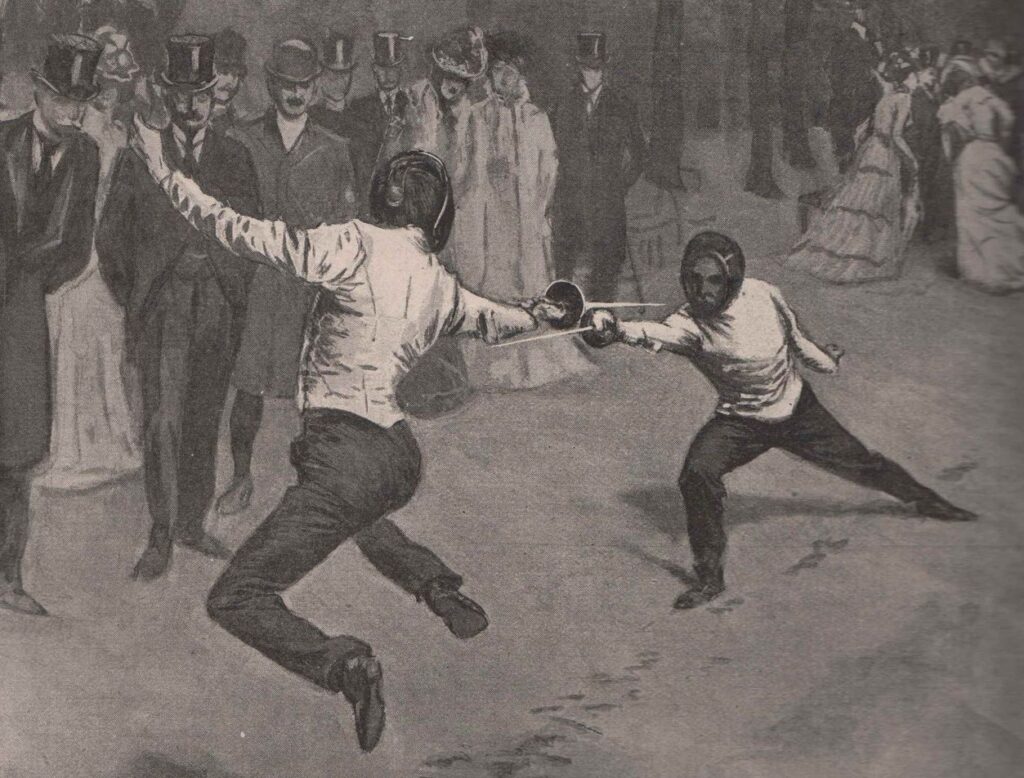
My final word, albeit it savour of egotism, shall be one of practical testimony and counsel to a generation of students. I must add my voice to those of a long chain of authorities, medical and other, to bear witness that the exercise of arms, whether in the school of the small-sword, or in the practice, more congenial, perhaps, to the English nature, of the sturdier sabre, is the most admirable of regular correctives for the ill habits of a sedentary life. It is as true now as when George Silver wrote it under Queen Elizabeth that “the exercising of weapons putteth away aches, griefs, and diseases, it increaseth strength and sharpeneth the wits, it giveth a perfect judgment, it expelleth melancholy, choleric and evil conceits, it keepeth a man in breath, perfect health, and long life.”
The Baron de Cosson has kindly made notes on some of the points mentioned in the foregoing essay, of which the communication has been accidentally delayed. I can now state on his authority that thrusting swords of triangular and quadrangular section certainly occur in genuine examples as early as the end of the fifteenth century. Most of these examples are German: they were called Panzerstecher, and were made for penetrating between the plates of sheet armour or breaking through chain-mail. Swords with short, rigid, four-sided blades, tapering to a very acute point, occur as early as the fourteenth century. These would seem to be descendants of the cultelli triacumines of Bovines.
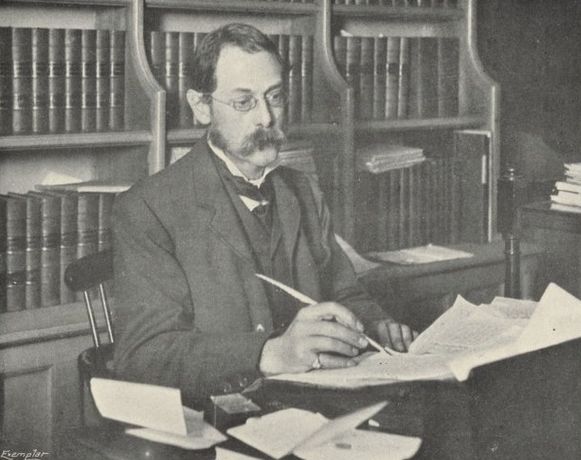
(1845-1937)
__________________________________
[1] Much Ado About Nothing – Act 2, Scene 3 [ed.]
[2] It is not universally true that bronze was known and worked before other metals. Iron came first where, as in Africa, it was most accessible. But I speak here with a view to the European development only.
[3] Richard I is made to wield a two-handed sword, a weapon unknown in his time, and used only by foot-soldiers when it did come in some three centuries later; and Saladin’s is described as having a narrow curved blade, whereas Indo-Persian sabres are, on the average, broader if anything than European swords.

